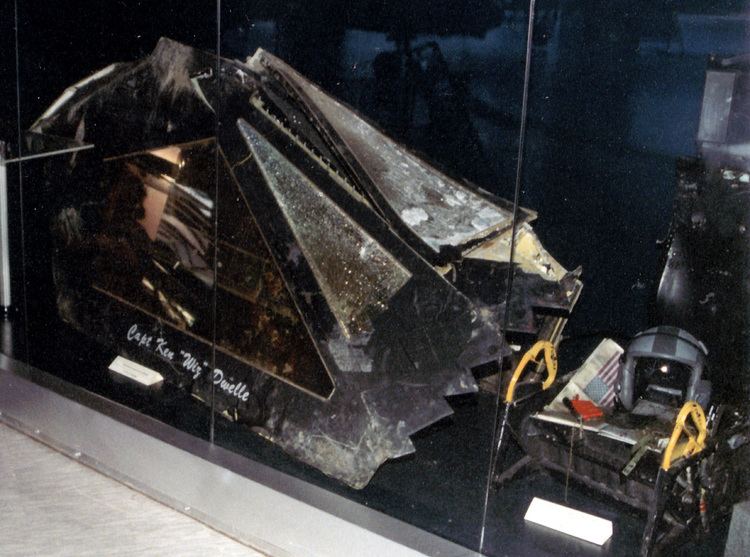 | ||
The 1999 F-117A shootdown was an event that took place on 27 March 1999, during the NATO bombing of Yugoslavia, (Operation Allied Force, Operation Noble Anvil), when an Army of Yugoslavia unit used an S-125 Neva/Pechora to down a Lockheed F-117 Nighthawk stealth aircraft of the United States Air Force. The pilot ejected and was rescued by search and rescue forces.
Contents
The U.S. Air Force F-117A was developed in the 1970s, entering service in 1983 and officially revealed in 1988. It saw its first combat in 1989 over Panama, and was widely seen as one of the most advanced pieces of U.S. military equipment. At the same time, Yugoslavian air defenses were seen as relatively obsolete.
Downing
Unknown to NATO, Yugoslav air defenses operators had found they could detect F-117s with their obsolete Soviet radars after some modifications. In 2005, Colonel Dale Zelko confirmed this in an interview, suggesting that those modifications involved using long wavelengths, which allowed them to detect the aircraft when the wheel well or bomb bay doors were open. In addition, the Serbs had also intercepted and deciphered some NATO communications, and thus were able to deploy their anti-air batteries at positions best suited to intercept NATO planes.
On 27 March 1999, the 3rd Battalion of the 250th Air Defence Missile Brigade of the Army of Yugoslavia, under the command of Colonel Dani, downed F-117 Air Force serial number 82-0806, callsign "Vega 31".
The Army of Yugoslavia unit was equipped with a Yugoslav version of the Soviet Isayev S-125 "Neva" missile system (NATO reporting name, SA-3 "Goa").
At about 8:15 pm local time, with a range of about 8 miles (13 km) several missiles were launched. According to Sergeant Dragan Matić, who was identified in 2009 as the soldier who fired the missiles, they detected the F-117 at a range of about 50 to 60 kilometres (31 to 37 mi), operating their equipment for no more than 17 seconds to avoid being locked on to by NATO anti-air suppression. According to Dani in a 2007 interview, his troops spotted the aircraft on radar when its bomb-bay doors opened, raising its radar signature.
The F-117, callsign "Vega-31", was being flown by Lt. Col. Dale Zelko, an Operation Desert Storm veteran. He observed the two missiles punch through the low cloud cover and head straight for his aircraft. The first passed over him, close enough to cause buffeting, but did not detonate. The second missile detonated, causing significant damage to the aircraft and causing it to tumble, out of control. The explosion was large enough to be seen from a KC-135 Stratotanker, flying over Bosnia.
Zelko was subject to intense g-forces as the aircraft tumbled and had great difficulty in assuming the correct posture for ejecting. After his parachute deployed, he used his survival radio to issue a mayday call and was able to contact the KC-135 that had seen him shot down. Zelko used his survival radio while still descending although this was contrary to his training. He reasoned the altitude would give his signal the best possible range and was also sure he would be quickly taken prisoner by Yugoslavian forces on the ground and wanted to confirm he was unhurt before this happened.
Zelko landed in a field south of Ruma and around a mile south of a four-lane highway. He quickly concealed himself in a drainage ditch that he had identified as a hole-up site while descending. There, he felt the shock waves of American bombs dropped by B-2 bombers on targets on the outskirts of Belgrade. Zelko landed around a mile from his aircraft's crash site, and an intensive search of the area was carried out by the Yugoslav soldiers, police and local villagers. At one point, searchers came within a few hundred yards of the ditch he was hiding in. Zelko was rescued approximately eight hours later by a U.S. Air Force combat search and rescue team flying in a Sikorsky MH-53 helicopter in the early hours of the next morning. According to Zelko, he would later learn that he had been minutes away from being captured. He was initially misidentified in press reports, as the name "Capt Ken 'Wiz' Dwelle" was painted on the aircraft's canopy. The lost F-117 carried the name "Something Wicked" and had previously flown 39 sorties during Operation Desert Storm.
The 250th Air Defence Missile Brigade also shot down a USAF F-16 fighter on 2 May 1999. These were the only two successes out of the dozens of ground-to-air missiles fired during the conflict.
Aftermath
Photographs show that the aircraft struck the ground at low speed in an inverted position, and that the airframe remained relatively intact. Some pieces of the F-117's wreckage are preserved at the Serbian Museum of Aviation in Belgrade, other pieces of wreckage were reportedly sent to Russia and China, to be used in developing anti-stealth technology. The USAF retired the F-117 in 2008.
Zoltán Dani, now running a bakery, and Dale Zelko, now retired from the US Air Force, have met and developed a friendship in recent years.
